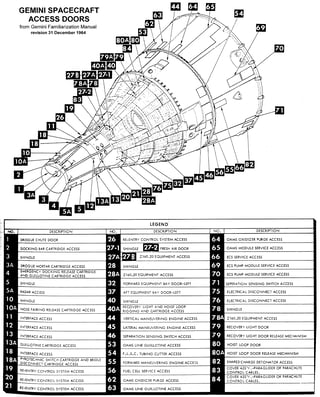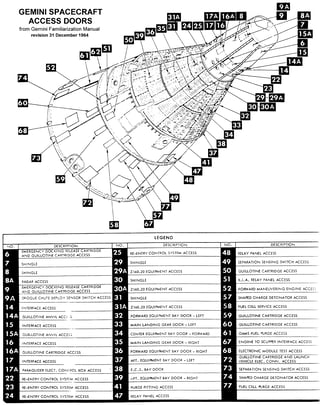What are these (circled in red) protruding from the retrograde section of the Gemini spacecraft?
-
3$\begingroup$ Looking for a source now, but I think they may be additional cameras mounted specifically for rendezvous missions. I don't see them on any design drawings of the retro section that I've found so far. $\endgroup$– Russell BorogoveCommented Feb 19, 2023 at 22:06
-
1$\begingroup$ What is the source of the image? It might help to know. $\endgroup$– Organic MarbleCommented Feb 21, 2023 at 2:28
2 Answers
Science packages beneath spring-loaded doors
This is a bit of a walk-through of my research to discover the answer. I found a second image that shows one of those same objects. (Click on any image to enlarge.)

Image courtesy False Steps: The Space Race as it Might have Been.
At the top of the retrograde module. It's casting two shadows to the left, one of the flap and another of the object itself. What tipped me off was the door that appears to cover the object during launch. Thus, I thought, we're looking for an access door.


Images courtesy NASA.
Except that apparently they're not considered access doors. Neither of the two locations shown in your original image are shown on the images above.
We're further tantalized by Reentry - An Orbital Simulator, which includes a simulation of the Gemini spacecraft. The game manual's Gemini flight manual cover page shows the object we're looking for (but on the leading edge of the retrograde module rather than the tail edge where it actually existed).
But as amazingly thorough as the flight manual is, it doesn't appear to explain the object. (Disclaimer: the manual's 200 pages long. I didn't read it all.)
What that game's flight manual did explain is that all the equipment for rendezvous missions is in the nose of the ship. I can't claim that the game is perfectly accurate... but check out the manual. They went to a lot of effort to be accurate. But that led me away from rendezvous equipment.
So, what are they?
All of the above finally led me to ask the question, "what would I find in the retrograde module that wasn't thrusters or rockets and not hidden under maintenance access panels?"
What they are, are scientific experiment packages beneath spring-loaded doors during launch and extended when the experiment is scheduled to proceed.
Unfortunately, different missions had different equipment that were under those spring-loaded doors. From this site we learn that (emphasis mine)...
The horizon scanners themselves were jettisoned at Retro Jett. Spacecraft 6 and later had a 0.4m long docking bar which was jettisoned at the same time. The retro module has four 11kN solid rockets which fire at 5.5s intervals, reducing speed by 0.10 km/s. Spacecraft 9 and later had two jettisonable window covers. Experiments D-4,7,10,12,15,16 and MSC-1,2,3,6 and S-9 had spring-loaded doors or booms that may have been jettisoned.
...
MSC-1 was a charge sensor with a jettisonable fairing on the retro section, on SC 4 and 5. The MSC-3 magnetometer was on a 1.0m boom from the adapter. The MSC-6 spectrometer on the adapter section had a spring loaded door, as did the S-9 (retro section) emulsion package.
As mentioned, the problem is that different missions had different objects beneath spring-loaded doors. Regrettably, this means that without knowing exactly which mission that photograph represents, we might never know exactly what those objects in that specific picture are. But they could have been any of several test equipment and/or sensors.
- Experiment D-4: Celestial radiometry
- Experiment D-7: Space object radiometry
- Experiment D-10: Ion-sensing altitude control
- Experiment D-12: Astronaut maneuvering unit
- Experiment D-15: Night image intensification
- Experiment D-16: Power tool evaluation
- Experiment MSC-1: Electrostatic charge
- Experiment MSC-2: Proton electron spectrometer
- Experiment MSC-3: Tri-axis magnetometer
- Experiment MSC-6: Beta spectrometer
- Experiment S-9: Nuclear emulsion
And we have a good idea what those packages are
My thanks to @RussellBorogrove for bringing some definitive info about your image to light. Per NASA, it's definitely the Gemini VII orbiter. That orbiter had the following packages that had either spring doors or booms: D-4, D-7, MSC-2 and MSC-3.
Now that we know definitively which Gemini mission we're looking at, it's required that either two of the packages are deployed and hiding behind the nose of the crew cabin (due to the angle of the photograph) or are simply not deployed. We know that MSC-3 has a one meter boom that isn't in the photo, that leaves those two exposed packages being two of the following three (assuming that D-4 and D-7 weren't combined, which is possible):
- Experiment D-4: Celestial radiometry
- Experiment D-7: Space object radiometry
- Experiment MSC-2: Proton electron spectrometer
-
2$\begingroup$ Great sleuthing. During my investigation of the question I saw OP's picture captioned as Gemini VII; it almost certainly has to be VI or VII, as I don't believe photos were recovered from any of the autonomous docking tagets. I don't think the left-hand feature in the picture is actually at the leading edge of the retro section; it's just foreshortened. VII did carry many of your candidate experiments. planet4589.org/home/legacy/space/book/html.old/progs1/nasa/… $\endgroup$ Commented Feb 21, 2023 at 20:18
-
$\begingroup$ Is Gemini 6A a better fit? This NASA page says it’s 7 taken from 6A, but it wouldn’t shock me if it was the other way around. nasa.gov/image-feature/gemini-vii-and-gemini-vi-a-meet-at-last $\endgroup$ Commented Feb 22, 2023 at 0:06
-
$\begingroup$ Thanks, @RussellBorogove, I believe that NASA article and image seals the deal. Unless NASA made a whomping mistake, we're definitely looking at VII. $\endgroup$– JBHCommented Feb 22, 2023 at 0:20
JBH has already pretty much answered the question, so this is just an additional:
The Gemini Program: Physical sciences experiments summary document actually has the same photo as the OP and states:
The cryogenic spectrometer and radiometer erected on the Gemini VII spacecraft
There are photos of the actual experiments in the document as well, as well as showing their locations.
Thus: Top left in the OP photo is the Proton electron spectrometer and bottom right is the radiometer.
...
Not to take away from the brilliant research in JBH's great answer, I noticed something about radiometer access hatch in one of Gemini's drawings in the manual.
This then led me to this link:
http://www.collectspace.com/ubb/Forum29/HTML/002005.html
which essentially asks similar questions, about a photo of Gemini VII:
resulting in:
Go4Launch posted:
These experiments, formally known as Celestial Radiometry and Space-Object Radiometry (D004 and D007), also flew on Gemini V. According to "The Gemini Program Physical Sciences Experiments Summary:"
The radiometer and spectrometers were mounted on swingout arms in the Gemini retroadapter section. Doors in the adapter were opened pyrotechnically, and the three sensing units swung through the openings into boresight alignment with the spacecraft optical sight. After the sensing units were erected, the spacecraft was pointed at the desired region for measurement.
The Gemini Program: Physical sciences experiments summary
https://ntrs.nasa.gov/citations/19720003207
Hires photo on flickr:
https://www.flickr.com/photos/nasa2explore/9492725107
pictures overlaid:
-
1$\begingroup$ Great link to the document! Thanks. $\endgroup$ Commented Feb 21, 2023 at 23:25
-
1$\begingroup$ Wow! Great find of those images identifying the packages! $\endgroup$– JBHCommented Feb 22, 2023 at 3:31






